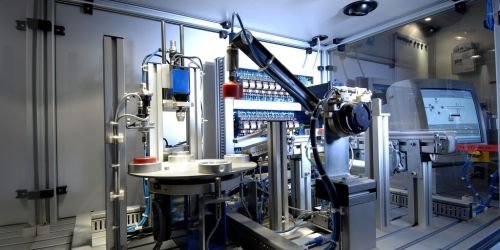CE Certification / CE Marking of Machinery Directive 2006/42/EC

Machinery Directive 2006/42/EC
CE Declaration of Conformity for Machines
The CE Declaration of Conformity (DoC) is a vital document within the framework of European Union (EU) legislation, particularly concerning the Machinery Directive 2006/42/EC. This directive outlines essential health and safety requirements for machinery and sets forth the necessary conditions for market access within the EU. The CE DoC serves as a formal statement by the manufacturer that their machinery complies with all applicable EU regulations, thereby affirming their commitment to product safety and performance standards.
The significance of the CE Declaration of Conformity cannot be overstated. It not only provides a clear and structured method for demonstrating compliance with EU legislation but also serves as a critical assurance to users and regulatory bodies regarding the product’s safety and operational efficiency. By obtaining a CE DoC, manufacturers can effectively navigate the complexities of the European market, ensuring that their machinery meets both legal obligations and the expectations of consumers.
CE marking, which accompanies the Declaration of Conformity, represents a key component of this compliance process. The marking indicates that the product has been assessed and meets the stringent requirements set by applicable EU directives. This symbol not only facilitates the movement of goods across borders within the EU but also plays a crucial role in reinforcing a manufacturer’s reputation for quality and safety in an increasingly competitive environment.
For manufacturers of machinery and equipment, understanding the CE Declaration of Conformity is essential. This knowledge not only helps ensure adherence to the relevant directives but also enhances overall product credibility. Consequently, the CE DoC is not merely a regulatory requirement; it is a testament to a manufacturer’s dedication to upholding the highest standards of machine safety and performance in the European market.
Understanding the Machinery Directive 2006/42/EC
The Machinery Directive 2006/42/EC is a fundamental regulation within the European Union that sets essential health and safety requirements for machinery. This directive applies to a wide array of machinery, including industrial equipment, construction machinery, and agricultural tools. Its scope encompasses not only machines for production but also partly completed machinery, which is defined as equipment that cannot perform a standalone function but is intended to be integrated into other machinery systems.
One of the primary goals of the Machinery Directive is to ensure the safety of machinery used within the EU by laying down essential health and safety standards. These requirements include comprehensive measures related to the design and manufacturing processes, with an emphasis on minimizing risks associated with machinery operation. Manufacturers must consider potential hazards, such as electrical, mechanical, thermal, and ergonomic risks, during the design phase to comply with the directive.
To achieve compliance with the Machinery Directive, manufacturers are required to conduct a conformity assessment. This process involves evaluating the machinery against the established safety requirements to determine if it meets the necessary criteria. Manufacturers must maintain comprehensive documentation, including technical files and risk assessments, which outline how the machinery complies with the directive’s provisions.
Non-compliance with the Machinery Directive can result in severe repercussions, including fines, product recalls, or, in extreme cases, withdrawal from the market. This emphasizes the necessity for manufacturers to understand their responsibilities regarding compliance and the importance of adhering to EU regulations. Furthermore, the directive helps harmonize safety standards across EU member states, facilitating smoother trade and enhancing the safety of machinery available in the marketplace.

Machinery Inspections CE Marking
Benefits and Requirements of CE Certification
CE certification plays a pivotal role in ensuring that machinery and equipment conform to European standards, resulting in numerous benefits for manufacturers. One of the primary advantages of obtaining CE certification is enhanced market access within the European Union. This certification essentially acts as a passport that allows manufacturers to market their products freely in EU member states, eliminating barriers associated with different national regulations. Hence, businesses can broaden their reach, facilitating greater sales opportunities and fostering growth.
Furthermore, CE certification significantly boosts customer trust. When consumers notice the CE mark on a product, they can confidently assume that the machinery has undergone rigorous testing and adheres to essential safety, health, and environmental protection standards. This trust is crucial in maintaining a competitive edge, as customers increasingly prioritize certified products when making purchasing decisions.
In addition to market access and customer trust, CE certification aids in improving product quality and safety. The rigorous assessment processes that come with certification encourage manufacturers to enhance their quality control systems and safety measures, thereby leading to reductions in defects and accidents. Consequently, companies are likely to experience lower liability risks and potential recalls, which can be financially devastating.
To achieve CE certification, manufacturers must meet specific requirements. This process involves the preparation of comprehensive documentation, including technical files that outline product specifications and risk assessments that identify potential hazards associated with the machinery. In many instances, the role of notified bodies becomes necessary, especially for products that necessitate a third-party evaluation. These bodies assist in the assessment process, ensuring that all regulatory necessities are adequately addressed. However, manufacturers often face challenges during certification, such as unfamiliarity with regulatory requirements or inadequate internal compliance processes. Proper planning, continuous education, and collaboration with experienced consultants can significantly enhance success in navigating the complexities of CE certification.

Machinery Tests and EN Standards 2006/42/EC
The Importance of Machine Tests and EN Standards
Ensuring the compliance of machinery with safety and performance criteria is of paramount importance in protecting both users and the environment. Conducting machine tests in accordance with European Norms (EN standards) is an essential part of this compliance process. These tests evaluate how machinery operates under various conditions, determining its reliability, safety, and efficiency. Some of the key types of tests include performance tests, safety assessments, and durability evaluations. Each type serves a specific purpose, contributing to a comprehensive understanding of the machinery’s capabilities and potential risks.
Moreover, adhering to EN standards is not merely a regulatory requirement; it is also a commitment to quality and safety. EN standards are developed through collaboration among experts in various fields and cover a vast array of machinery types. This ensures that all machinery adheres to a recognized baseline of safety and functionality that is accepted across Europe. Commonly referenced standards include EN ISO 12100 for safety of machinery, EN 60204-1 for electrical equipment, and EN ISO 13849-1 addressing safety-related parts of control systems. Familiarity with these standards is crucial for manufacturers aiming to navigate the complex landscape of compliance effectively.
Utilizing third-party testing organizations is vital in the compliance process. These independent entities conduct thorough examinations and assessments, providing impartial test results which contribute significantly to the credibility of the compliance process. Documenting these test results systematically is also essential, as they serve as documented evidence of conformity to safety directives. This documentation not only bolsters the case for issuing a CE certificate but also stands as proof of compliance in case of regulatory audits or customer inquiries.
How Can We Assist You?
Would you like to learn more about our services? Feel free to contact us today!
If you’re interested in professional certification, we’d be happy to provide you with an excellent price offer.
CE Certification / CE Marking of Machinery Directive 2006/42/EC

Machinery Directive 2006/42/EC
CE Declaration of Conformity for Machines
The CE Declaration of Conformity (DoC) is a vital document within the framework of European Union (EU) legislation, particularly concerning the Machinery Directive 2006/42/EC. This directive outlines essential health and safety requirements for machinery and sets forth the necessary conditions for market access within the EU. The CE DoC serves as a formal statement by the manufacturer that their machinery complies with all applicable EU regulations, thereby affirming their commitment to product safety and performance standards.
The significance of the CE Declaration of Conformity cannot be overstated. It not only provides a clear and structured method for demonstrating compliance with EU legislation but also serves as a critical assurance to users and regulatory bodies regarding the product’s safety and operational efficiency. By obtaining a CE DoC, manufacturers can effectively navigate the complexities of the European market, ensuring that their machinery meets both legal obligations and the expectations of consumers.
CE marking, which accompanies the Declaration of Conformity, represents a key component of this compliance process. The marking indicates that the product has been assessed and meets the stringent requirements set by applicable EU directives. This symbol not only facilitates the movement of goods across borders within the EU but also plays a crucial role in reinforcing a manufacturer’s reputation for quality and safety in an increasingly competitive environment.
For manufacturers of machinery and equipment, understanding the CE Declaration of Conformity is essential. This knowledge not only helps ensure adherence to the relevant directives but also enhances overall product credibility. Consequently, the CE DoC is not merely a regulatory requirement; it is a testament to a manufacturer’s dedication to upholding the highest standards of machine safety and performance in the European market.
Understanding the Machinery Directive 2006/42/EC
The Machinery Directive 2006/42/EC is a fundamental regulation within the European Union that sets essential health and safety requirements for machinery. This directive applies to a wide array of machinery, including industrial equipment, construction machinery, and agricultural tools. Its scope encompasses not only machines for production but also partly completed machinery, which is defined as equipment that cannot perform a standalone function but is intended to be integrated into other machinery systems.
One of the primary goals of the Machinery Directive is to ensure the safety of machinery used within the EU by laying down essential health and safety standards. These requirements include comprehensive measures related to the design and manufacturing processes, with an emphasis on minimizing risks associated with machinery operation. Manufacturers must consider potential hazards, such as electrical, mechanical, thermal, and ergonomic risks, during the design phase to comply with the directive.
To achieve compliance with the Machinery Directive, manufacturers are required to conduct a conformity assessment. This process involves evaluating the machinery against the established safety requirements to determine if it meets the necessary criteria. Manufacturers must maintain comprehensive documentation, including technical files and risk assessments, which outline how the machinery complies with the directive’s provisions.
Non-compliance with the Machinery Directive can result in severe repercussions, including fines, product recalls, or, in extreme cases, withdrawal from the market. This emphasizes the necessity for manufacturers to understand their responsibilities regarding compliance and the importance of adhering to EU regulations. Furthermore, the directive helps harmonize safety standards across EU member states, facilitating smoother trade and enhancing the safety of machinery available in the marketplace.

Machinery Inspections CE Marking
Benefits and Requirements of CE Certification
CE certification plays a pivotal role in ensuring that machinery and equipment conform to European standards, resulting in numerous benefits for manufacturers. One of the primary advantages of obtaining CE certification is enhanced market access within the European Union. This certification essentially acts as a passport that allows manufacturers to market their products freely in EU member states, eliminating barriers associated with different national regulations. Hence, businesses can broaden their reach, facilitating greater sales opportunities and fostering growth.
Furthermore, CE certification significantly boosts customer trust. When consumers notice the CE mark on a product, they can confidently assume that the machinery has undergone rigorous testing and adheres to essential safety, health, and environmental protection standards. This trust is crucial in maintaining a competitive edge, as customers increasingly prioritize certified products when making purchasing decisions.
In addition to market access and customer trust, CE certification aids in improving product quality and safety. The rigorous assessment processes that come with certification encourage manufacturers to enhance their quality control systems and safety measures, thereby leading to reductions in defects and accidents. Consequently, companies are likely to experience lower liability risks and potential recalls, which can be financially devastating.
To achieve CE certification, manufacturers must meet specific requirements. This process involves the preparation of comprehensive documentation, including technical files that outline product specifications and risk assessments that identify potential hazards associated with the machinery. In many instances, the role of notified bodies becomes necessary, especially for products that necessitate a third-party evaluation. These bodies assist in the assessment process, ensuring that all regulatory necessities are adequately addressed. However, manufacturers often face challenges during certification, such as unfamiliarity with regulatory requirements or inadequate internal compliance processes. Proper planning, continuous education, and collaboration with experienced consultants can significantly enhance success in navigating the complexities of CE certification.

Machinery Tests and EN Standards 2006/42/EC
The Importance of Machine Tests and EN Standards
Ensuring the compliance of machinery with safety and performance criteria is of paramount importance in protecting both users and the environment. Conducting machine tests in accordance with European Norms (EN standards) is an essential part of this compliance process. These tests evaluate how machinery operates under various conditions, determining its reliability, safety, and efficiency. Some of the key types of tests include performance tests, safety assessments, and durability evaluations. Each type serves a specific purpose, contributing to a comprehensive understanding of the machinery’s capabilities and potential risks.
Moreover, adhering to EN standards is not merely a regulatory requirement; it is also a commitment to quality and safety. EN standards are developed through collaboration among experts in various fields and cover a vast array of machinery types. This ensures that all machinery adheres to a recognized baseline of safety and functionality that is accepted across Europe. Commonly referenced standards include EN ISO 12100 for safety of machinery, EN 60204-1 for electrical equipment, and EN ISO 13849-1 addressing safety-related parts of control systems. Familiarity with these standards is crucial for manufacturers aiming to navigate the complex landscape of compliance effectively.
Utilizing third-party testing organizations is vital in the compliance process. These independent entities conduct thorough examinations and assessments, providing impartial test results which contribute significantly to the credibility of the compliance process. Documenting these test results systematically is also essential, as they serve as documented evidence of conformity to safety directives. This documentation not only bolsters the case for issuing a CE certificate but also stands as proof of compliance in case of regulatory audits or customer inquiries.
How Can We Assist You?
Would you like to learn more about our services? Feel free to contact us today!
If you’re interested in professional certification, we’d be happy to provide you with an excellent price offer.

